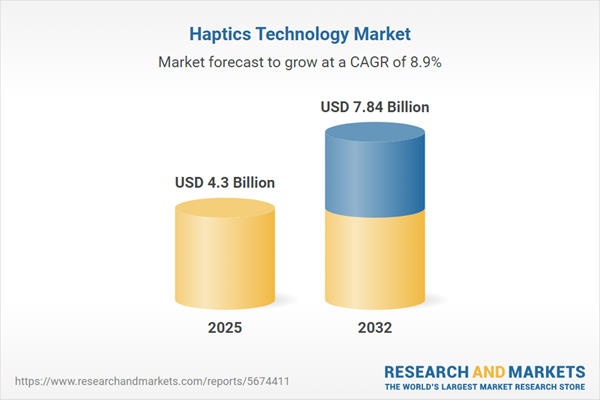Speak directly to the analyst to clarify any post sales queries you may have.
Haptics technology is fast emerging as a strategic pillar in digital interface design, enabling lifelike tactile feedback that elevates user engagement across industries. As global adoption accelerates, organizations are leveraging advanced haptics to unlock new dimensions in immersive experience and operational efficiency.
Market Snapshot: Haptics Technology Market Size and Growth
The Haptics Technology Market grew from USD 3.97 billion in 2024 to USD 4.30 billion in 2025. It is expected to continue growing at a CAGR of 8.88%, reaching USD 7.84 billion by 2032.
The market’s expansion is driven by rapid innovation, strong cross-sector demand, and integration within next-generation consumer electronics and industrial equipment.Scope & Segmentation: Technology, Applications, and Regions
- Component: Actuators (Electroactive Polymers, Electromagnetic Actuators, Piezoelectric Actuators, Pneumatic Actuators), Controllers, Sensors (Motion Sensors, Pressure Sensors, Touch Sensors), Software
- Technology Type: Force Haptics, Tactile Haptics
- Connectivity: Wired Haptic Devices, Wireless Haptic Devices
- Application: Automotive (Advanced Driver Assistance Systems, Infotainment), Consumer Electronics (Gaming Consoles, Smartphones, Tablets, Wearables), Healthcare (Medical Devices, Rehabilitation Equipment), Industrial (Robotics, Virtual Reality Training)
- End User: Aftermarket, OEMs
- Geography: Americas (North America: United States, Canada, Mexico; Latin America: Brazil, Argentina, Chile, Colombia, Peru), Europe, Middle East & Africa (Europe: United Kingdom, Germany, France, Russia, Italy, Spain, Netherlands, Sweden, Poland, Switzerland; Middle East: United Arab Emirates, Saudi Arabia, Qatar, Turkey, Israel; Africa: South Africa, Nigeria, Egypt, Kenya), Asia-Pacific (China, India, Japan, Australia, South Korea, Indonesia, Thailand, Malaysia, Singapore, Taiwan)
- Companies Covered: Texas Instruments Inc., Johnson Electric Holdings Limited, 3D Systems, Inc., Microchip Technology Inc., Force Dimension, HAPTION SA, Immersion Corporation, TDK Corporation, Samsung Electronics Co., Ltd., Tanvas, Inc., Ultraleap Limited, Tactical Haptics, Inc., HaptX Inc., D-BOX Technologies Inc., Boréas Technologies Inc., Interhaptics by Razer Inc., Elara Systems, Inc., Vibra Nova, Sony Corporation, Nokia Corporation, Merkel Haptic Systems Pvt Ltd., KEMET by Yageo Corporation, Meta Platforms, Inc, Analog Devices, Inc.
Key Takeaways: Strategic Insights for Senior Decision-Makers
- Haptics innovations are now core to human-machine interaction, delivering realistic tactile feedback in products ranging from wearables to virtual reality systems.
- Integrated software and miniaturized actuators are enabling multi-modal and customizable user experiences, directly influencing both product differentiation and operational performance in enterprise environments.
- Growing cross-industry partnerships and regional research investments are expediting the deployment of haptic solutions, particularly in healthcare, automotive, and advanced manufacturing.
- Adaptation to supply chain interruptions, such as policy-driven disruptions, is reshaping component sourcing strategies, underscoring the importance of multi-region procurement and resilient manufacturing partnerships.
- Rising regulatory scrutiny and new safety mandates in markets like Europe and North America are redefining design cycles and increasing the value of early-stage compliance planning for haptics-enabled devices.
Tariff Impact: Navigating Trade Dynamics in the Haptics Technology Market
Recent tariffs in the United States have increased component costs and spurred shifts in supply chain management. OEMs are reassessing their supplier networks and making investments in alternative manufacturing locales to mitigate risk and maintain continuity. This trend is accelerating moves toward diversified sourcing and strategic inventory planning.
Methodology & Data Sources
Research findings are built on a rigorous methodology combining comprehensive secondary data analysis, targeted interviews with industry leaders, and triangulation to ensure accuracy. Sources include technical journals, patent reviews, regulatory filings, and senior stakeholder consultations to validate trend projections and segmentation insights.
Why This Report Matters: Actionable Guidance for the C-Suite
- Enables informed capital allocation and R&D prioritization through a detailed breakdown of haptics segments and market dynamics.
- Delivers clarity on regional drivers, regulatory requirements, and emerging partnership models to support global market entry strategies.
- Equips decision-makers to navigate tariff challenges and optimize supply chain resilience.
Conclusion
The haptics technology market presents a landscape of strong opportunity, shaped by technical innovation, evolving regulatory environments, and new collaborative models. Strategic foresight and targeted investment will be key to capturing value and sustaining market leadership in this dynamic sector.
Additional Product Information:
- Purchase of this report includes 1 year online access with quarterly updates.
- This report can be updated on request. Please contact our Customer Experience team using the Ask a Question widget on our website.
Table of Contents
3. Executive Summary
4. Market Overview
7. Cumulative Impact of Artificial Intelligence 2025
List of Figures
Samples

LOADING...
Companies Mentioned
The key companies profiled in this Haptics Technology market report include:- Texas Instruments Inc.
- Johnson Electric Holdings Limited
- 3D Systems, Inc.
- Microchip Technology Inc.
- Force Dimension
- HAPTION SA
- Immersion Corporation
- TDK Corporation
- Samsung Electronics Co., Ltd.
- Tanvas, Inc.
- Ultraleap Limited
- Tactical Haptics, Inc.
- HaptX Inc.
- D-BOX Technologies Inc.
- Boréas Technologies Inc.
- Interhaptics by Razer Inc.
- Elara Systems, Inc.
- Vibra Nova
- Sony Corporation
- Nokia Corporation
- Merkel Haptic Systems Pvt Ltd.
- KEMET by Yageo Corporation
- Meta Platforms, Inc
- Analog Devices, Inc.
Table Information
| Report Attribute | Details |
|---|---|
| No. of Pages | 194 |
| Published | October 2025 |
| Forecast Period | 2025 - 2032 |
| Estimated Market Value ( USD | $ 4.3 Billion |
| Forecasted Market Value ( USD | $ 7.84 Billion |
| Compound Annual Growth Rate | 8.8% |
| Regions Covered | Global |
| No. of Companies Mentioned | 25 |









